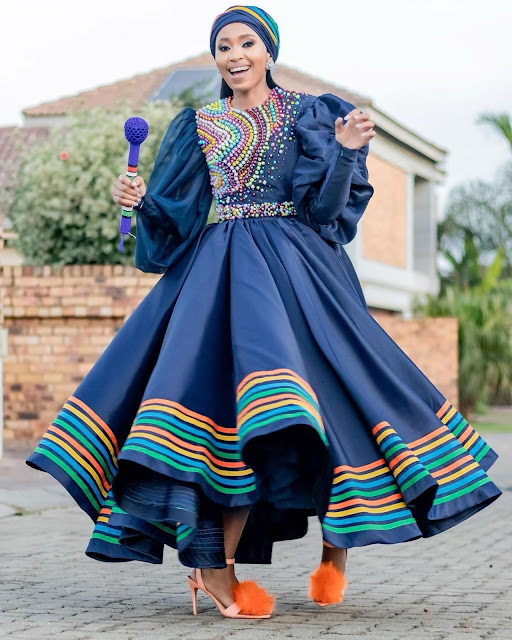Sepedi Traditional Dresses
Sepedi Traditional Attire: A Symphony of Colors and Patterns
Sepedi Traditional Attires are more than just clothing; they are a striking manifestation of history, pride, and a legacy that has persisted down the years. You will discover a lot about traditional Sepedi clothing in this post, including its significance in Southern African design.
A Rhapsody of Colors and Patterns in Sepedi Traditional Clothing
The vibrant colors of the terrain are reflected in the traditional Sepedi clothing, which is a visual masterpiece inspired by nature's color pallet. Their apparel beautifully combines earthy tones that mimic the fertile soil, deep blues that evoke the vast sky, and bold reds that denote passion and vitality. These colors tell stories about life, love, and spirituality in addition to being beautiful.
Yet, each garment is transformed into a beautiful work of art by the detailed patterns, not only the vibrant colors. The fabric is painstakingly weaved or embroidered with symbolic patterns, elaborate beadwork, and geometric designs. These designs serve as more than just ornaments; they stand for the Sepedi people's customs, principles, and aspirations.
The Evolution of Sepedi Traditional Clothing
The traditional clothing of the Sepedi people transcends time and carries echoes of the past. Each article of clothing serves as a link to the past and a transitional link between the old and the new. It provides a visual connection to the legends shared around campfires, the moonlit dances, and the rites that have shaped their culture.
The Shweshwe clothing, which is embellished with distinctive geometric patterns, represents the tenacious nature of Sepedi women. Its graceful shape and elaborate designs capture the beauty and strength of the women who wear it, exuding dignity and grace.
Contemporary Pedi Traditional Garb
The Sepedi people have managed to meld tradition with modernity as the world changes and civilizations mix. Modern Sepedi clothing embraces the comfort and ease of the present while preserving the essence of the past. Sepedi people proudly wear their traditional dress throughout ceremonies, festivities, and daily life, ensuring that their identity is preserved even as urbanization spreads across their landscapes.
The value of contemporary Sepedi traditional clothing to South Africa
Traditional Sepedi garb is more than just clothing; it is a rich source of pride and cultural importance. As the soul is captivated by their profound meanings, the eyes are captivated by their vivid colors and intricate patterns. Sepedi traditional clothing stands out as one of the most brilliant threads in the rich tapestry of Southern Africa's civilizations, a monument to the tenacity of a people who respect their history while boldly embracing the future.
Remember that Sepedi traditional attires are more than simply textiles and threads as you take in their beauty and majesty. They represent the living expression of a people's history, a history that is still being woven into the fabric of time.
Traditional Sepedi Clothes Types
Traditional Sepedi apparel and accessories come in a wide range of looks, and they have deep cultural and symbolic significance for the Sepedi people. These outfits are worn for a variety of ceremonies, parties, and significant life events. Here are some notable examples of Sepedi traditional clothing:
1. Shweshwe Dresses: Shweshwe gowns are a staple of Sepedi culture. The striking geometric designs and vivid colors of these dresses are well known. Dresses with flared or A-line silhouettes and elaborate beadwork, embroidery, and lace trims are frequently made using shweshwe fabric. During weddings, initiation rituals, and other joyous events, Sepedi women traditionally use shweshwe gowns.
2. Mokhukhu (Traditional Blanket): Among the Sepedi people, the mokhukhu is a traditional blanket that has significant cultural value. Men frequently wear these blankets as a part of their traditional clothing. The elaborate designs and patterns on the blankets, as well as how they are worn, convey various messages or symbolism throughout the society.
3.Doeks are vibrant head wraps that have a specific place in Sepedi traditional clothing. Doeks are used by women to adorn their heads on different occasions. Many meanings, such as marital status or mood, can be conveyed by the way a doek is tied. The doek is a way of cultural expression in addition to being a fashionable accessory.
4.Beadwork is an essential component of traditional Sepedi clothing. Jewelry made of beads, such as anklets, bracelets, and necklaces, is used by both sexes. Beads are frequently employed as symbols of ethnic identity, social standing, and religious convictions. The Sepedi people's artistry is evident in the beadwork's elaborate patterns and vibrant colors.
5.Seshoeshoe Dresses: The Sepedi community has embraced Seshoeshoe garments as another form of traditional clothing. These gowns, which frequently pair with matching head wraps, have fabric patterns with strong color contrasts. Seshoeshoe gowns have evolved into a style statement that combines heritage and modernity.
6. Leather Accessories: Sandals and belts made of leather are frequent additions to traditional Sepedi clothing. These accessories frequently have fine carving and decorative embellishments that improve the outfit's overall look.
7. As modernization takes place, the Sepedi people have discovered methods to blend traditional aspects into modern clothes. In order to preserve culture while keeping up with modern trends, this fusion comprises mixing Western-style clothing with conventional fabrics, patterns, and styles.
Below is some of theTypes of Seprdi Attires










